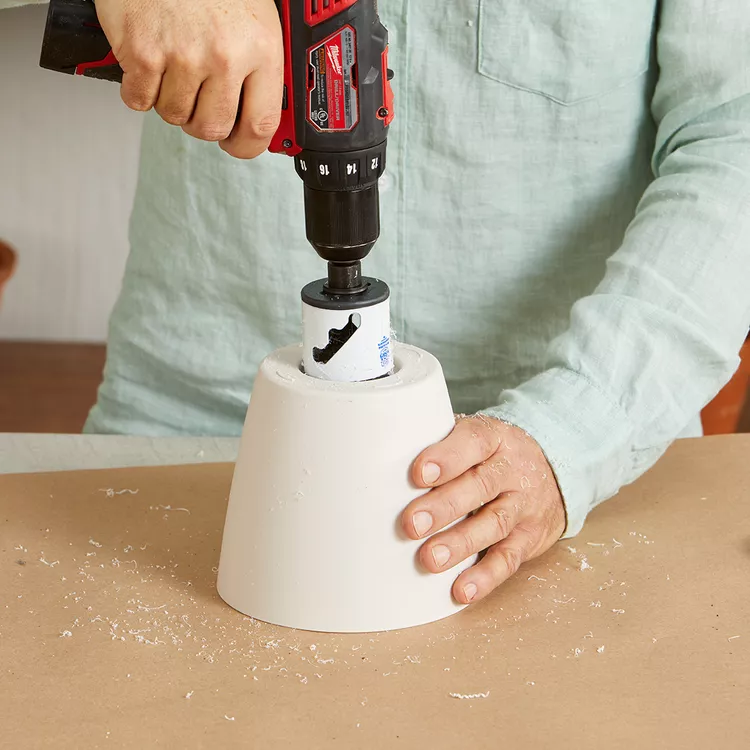- Working Time: 45 minutes
- Total Time: 45 minutes
- Skill Level: Beginner
Maximize your indoor planting space by turning to some often-overlooked retail: the ceiling. These innovative hanging planters literally turn things upside down, allowing herbs or other plants to dangle out the bottom of their pots instead of sticking out the top. A small piece of air conditioner filter ensures that no dirt falls on your countertops. You'll still water the plants from the top of the pot and the moisture will travel down to the roots.
What You'll Need
Equipment / Tools
- 2 1/2-inch hole saw
- Utility knife with new blade
- Scissors
- Ruler
- Drill
- 1/4-inch drill bit
Materials
- 6-inch plastic pot
- 1/8-inch nylon rope
- Window air conditioner filter
- Herb plant
Instructions
-
Cut Hole in Planter
Because your planter will hang upside down, you'll plant your herb through the bottom of the pot instead of the top. To fit it through, cut a 2-1/2-inch hole in the bottom of the pot using a hole saw. Use protective eyewear while cutting plastic.
-
![planter cut circle filter material]()
![scissors cut air conditioner filter]()
![scissors cut hole filter]()
PHOTO: Wade Scherrer PHOTO: Wade Scherrer PHOTO: Wade Scherrer Cut Out Filter
Using the bottom of the pot as a guide, use a utility knife to cut a circle from the air conditioner filter of the same size. Fold the foam piece into a cone and, using scissors, cut the tip of the cone to make a hole in the center of the circle. Then, cut a radius in the filter circle. Your piece should look like a donut with a line going through one side.
Related: How to Make a Lattice Plant Hanger
-
Drill Holes for Rope
Drill two 1/4-inch hanging holes on opposite sides of the pot. Place them 3/4 inch down from the top edge of the pot. You may want to drill over a piece of scrap wood to steady the pot while you work.
-
Thread Rope for Hanging
Thread one end of the rope through a hole from exterior to interior and tie a knot inside the pot to secure it. Repeat with the other side. You can use one continuous piece of rope or two single pieces depending on how you want to hang the pot. Temporarily hang the empty pot somewhere you can easily access it to work on planting.
-
![thread plant through bottom pot]()
![air filter plant]()
![potting soil upside down planter]()
PHOTO: Wade Scherrer PHOTO: Wade Scherrer PHOTO: Wade Scherrer Plant Herb and Hang
Remove your herb plant from its nursery pot and gently brush away enough soil from around its roots so that it fits through your container. Insert the root end of the plant in the hole you cut in the bottom of the planter. From the top opening of the pot, put the foam filter around the stems of the plant and press it into the bottom of the pot to prevent soil from spilling out. Fill the rest of the pot with soil, leaving an inch or two of space at the top for watering.
-
Hang Up Pot and Water
Hang your pot in the desired location. Water your plant from the top end of the pot. Add more water whenever the soil at the top feels dry.

:strip_icc():focal(699x0:701x2):format(webp)/cut-circle-in-air-conditioner-filter-9ab2916f-3776ac8793a141e88d76d04aa6f41af9.jpg)
:strip_icc():focal(539x0:541x2):format(webp)/trim-air-conditioner-filter-a3548fa8-5972da6fe64d42f8943e1f687c4b5e0f.jpg)
:strip_icc():focal(539x0:541x2):format(webp)/cut-a-radius-in-the-circle-of-the-air-conditioner-filter-a18a0c6f-01bdc2d483244d9a9c2e8bd3d3f1d6f3.jpg)
:strip_icc():focal(539x0:541x2):format(webp)/add-plant-to-bottom-hole-in-pot-6ba143a7-7dfeda29ef2543e3b57461f356c3d6f9.jpg)
:strip_icc():focal(539x0:541x2):format(webp)/add-air-conditioner-filter-to-planter-a8489b5a-2fc63ed5925448839e8c36000ce8572e.jpg)
:strip_icc():focal(539x0:541x2):format(webp)/adding-potting-soil-to-upside-down-planter-23e7505a-b0b9e7e7ac134ed49263a73dbe972726.jpg)



















